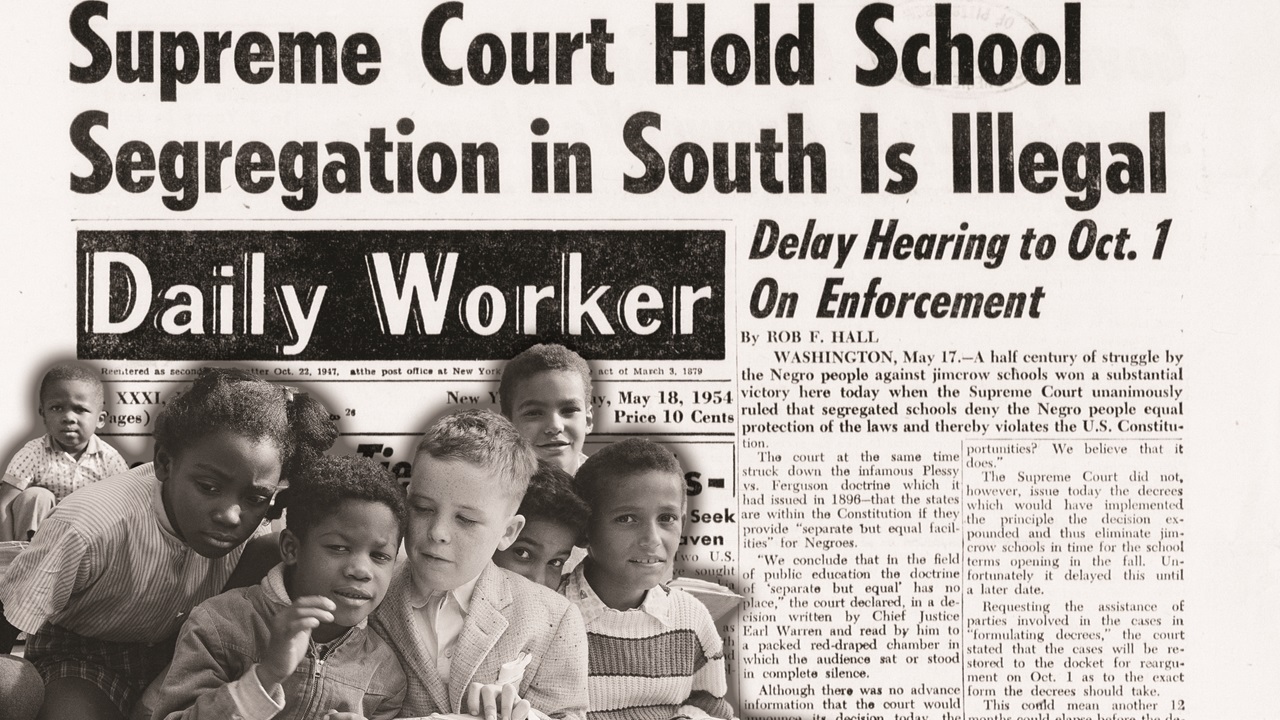
This article is part of the People’s World 100th Anniversary Series.
Seventy years ago, on May 17, 1954, the Supreme Court outlawed segregation in public schools with its landmark Brown v. Board of Education decision, delivering a hard-fought victory for the Civil Rights Movement and all those struggling for the equality of Black Americans.
The article below appeared in Daily Worker the next morning. Staff writer Rob Hall surveys the importance of the shock decision and the political earthquake it set off across the Jim Crow South within those first 24 hours. The article uses the term “Negro” rather than African American or Black American, as was the standard practice of the time.
Hall expresses hope that pressure from trade unions, the NAACP, and other progressive organizations will nudge Southern politicians to realize they’ve lost and quickly cave on the segregation question, but as his reporting shows, racist reaction was already rearing its head.
Many white supremacist governors and lawmakers in the South spent the next several years digging in their heels, even deploying the National Guard to block the integration of public schools. They were eventually all forced to submit, however, to the growing power of the forces favoring equality.
Nationally, the Republican Party moved to take advantage of the Democratic Party’s split between its racist Dixiecrat wing and the progressive coalition of unions, Black Americans, and other working people in the North and West. The GOP scheme culminated in the “Southern Strategy,” which relied on coded racism to pull white voters into their column and win their support for a broader right-wing agenda. It started with Nixon, was perfected by Reagan, continued under both Bushes, and reached new extremes under the Tea Party and later Trump.
Though the schools of the U.S. were eventually all officially integrated, seven decades of institutional racism and discrimination in everything from housing to employment leave many districts de-facto segregated today. Uneven funding and programming still deny students of color equal opportunity.
An enduring lesson of the struggle around segregation and the Brown case, however, is the need to appreciate the difference elections can make in determining the terrain of struggle for the movements. The question of who controls the executive, legislative, and judicial branches—at all levels—is not one to be ignored or downplayed.
Supreme Court Holds School Segregation in South is Illegal
By Rob Hall
Daily Worker – May 18, 1954
WASHINGTON (May 17)—A half-century of struggle by the Negro people against Jim Crow schools won a substantial victory here today when the Supreme Court unanimously ruled that segregated schools deny the Negro people equal protection of the laws and thereby violates the U.S. Constitution.
The court at the same time struck down the infamous Plessy vs. Ferguson doctrine which it had issued in 1896—that the states are within the Constitution if they provide “separate but equal facilities” for Negroes.
“We conclude that in the field of public education, the doctrine of ‘separate but equal’ has no place,” the court declared in a decision written by Chief Justice Earl Warren and read by him to a packed red-draped chamber in which the audience sat or stood in complete silence.
Although there was no advance information that the court would announce its decision today, the chamber and corridors were especially crowded. Especially numerous were Negro leaders, lawyers, and correspondents for the Negro press.
Both the day of the decision and its content constituted one of the best kept secrets in Washington history—up until the very moment that Warren, reading the decision, came on page 9 of the 12-page document to the paragraph:
“We come then to the question presented: Does segregation of children in public schools solely on the basis of race, even though the physical facilities and other ‘tangible’ factors may be equal, deprive children of the minority group of equal educational opportunities? We believe that it does.”
The Supreme Court did not, however, issue today the decrees which would have implemented the principle the decision expounded and thus eliminate Jim Crow schools in time for the school terms opening in the fall. Unfortunately, it delayed this until a later date.
Requesting the assistance of the parties in the cases in “formulating decrees,” the court stated that the cases will be restored to the document for reargument on Oct. 1 as to the exact form the decrees should take.
This could mean another 12 months could elapse before the decrees are issued and made applicable.
In examining the question [of segregation], the court said it concluded that to separate students either in grade or high schools “from others of similar age and qualification solely because of their race generates a feeling of inferiority as to their status in the community that may affect their hearts and minds in a way unlikely ever to be undone.”
Thurgood Marshall, special counsel for the NAACP, who argued the case against segregation before the court, said the decision was “the most significant to date in the field of civil rights.”
Commenting on threats from Dixiecrat leaders in Georgia and South Carolina to upset the court’s ruling by force or fraud, Marshall smiled. “I’m not worried about it not being honored in the Southern states,” he said. “I think Governors Talmage and Byrnes are speaking for themselves. The people in the South will follow the law.”
Change in South
Marshall did not elaborate, but observers here commented that the climate of opinion in the South has become progressively more liberal in recent years, especially since the growth of industry in that region and the coming of trade unions.
In a later interview in New York, Marshall predicted that within “a very few years from now,” all the segregation will be gone from the U.S.
Marshall also said if Georgia or any other Southern state tries to abolish their school system, “we will have them in court the same morning.”
It was believed the decision would be greeted by many white Southerners and that if the unions (most of which are on record for abolition of Jim Crow in schools) would rally their Southern locals and state organizations, they could be a powerful factor for the orderly acceptance of the law of the land.
If the court had issued the decrees today, to apply at once the just principle which its unanimous decision expressed, it would have been possible for three million Negro children to enter integrated schools in 17 states and the District of Columbia in September. As it now stands, these children must wait at least another year before the full force of the supreme law of the country is felt.
However, in those states where the progressive people’s organizations are strongest—the NAACP, the unions, etc.—it may be possible for them to persuade the state and local governments to act to end Jim Crow schools even before the high tribunal’s decrees are issued.
The Brown case came before the court after parents of Negro children in four states and D.C. filed action demanding that their children be admitted to lily white schools in their immediate neighborhoods. The states in which these cases originated are Kansas, South Carolina, Virginia, and Delaware.
There are 17 states and the District of Columbia which have laws requiring segregation in public education. During the arguments before the court, attorneys for the parents estimated that 10 million of the 15 million Negroes in this country live in these states. There are also three states—New Mexico, Wyoming, and Kansas—where Jim Crow schools are permitted [but not mandated].
The effect of the court decision, it was said, will be to notify these 20 states that they must proceed at once to integrate their school systems.

Gov. William B. Umstead of North Carolina said he is “terribly disappointed” at the court’s action but would comment no further until he has read the decision.
That line was taken by most other officials of high rank, such as Gov. Johnston Murray of Oklahoma, who said he plans no special session of the legislature immediately to discuss the issue. In Louisiana, the only Southern state with a legislature in session, Rep. Gilbert Faulk said he feels the assembly “should take immediate steps to counteract it.” In Clarendon County, S.C., where one of the cases involved in today’s action originated, school superintendent L.B. McCord said he feels “the time is not right” for mixed schools.
Several state legislatures, anticipating such a decision, moved as early as 1951 to preserve segregation practices regardless of the action.
The suggestion was made that South Carolina abolish the public school system and turn it over to the churches to operate on a subsidized and segregated basis. Church leaders said they would be reluctant to get involved.
In Georgia, the legislature incorporated in the present appropriations act a provision that all state funds will be automatically cut off from any non-segregated school. Lt. Gov Marvin Griffin, who will be a candidate for the governorship this year, said that so long as he holds public office in the state, “I will maintain segregation in the schools and the races will not be mixed, come hell or high water.”
In Mississippi, the legislature passed a bill designed to maintain segregation regardless of the court decision…. [It] authorized appointment of a study committee to find ways of maintaining segregation and making recommendations to the assembly….
Walter White, president of the NAACP, commented on the ruling: “As Joe Louis would say, I’m glad we won.” CIO President Walter Reuther termed the decision a “heart-warming reaffirmation of democratic principles.” AFL President George Meany greeted the decision as “keeping with what we feel is the American way of life.”
“It’s a matter of simple justice,” he said, “restating the sound principle that in our country there must be no discrimination of creed or color.”
We hope you appreciated this article. At People’s World, we believe news and information should be free and accessible to all, but we need your help. Our journalism is free of corporate influence and paywalls because we are totally reader-supported. Only you, our readers and supporters, make this possible. If you enjoy reading People’s World and the stories we bring you, please support our work by donating or becoming a monthly sustainer today. Thank you!










